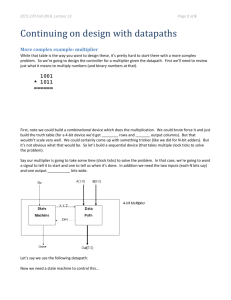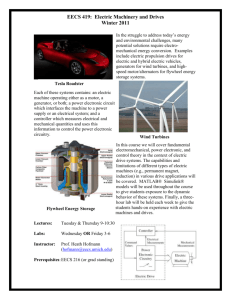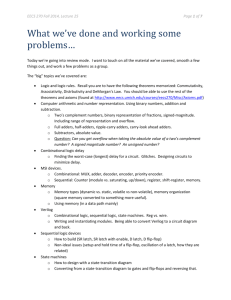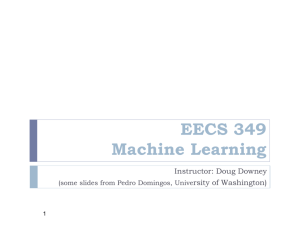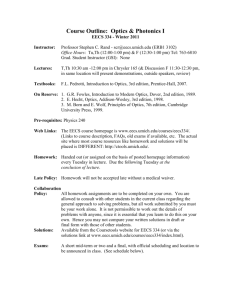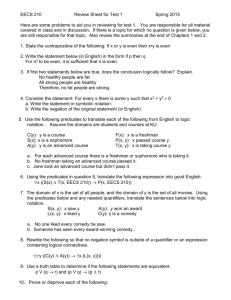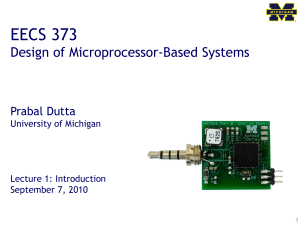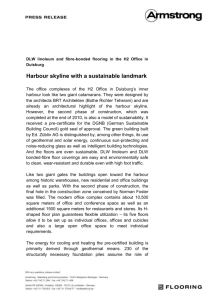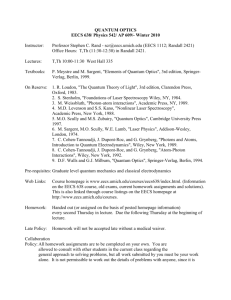Lecture 1
advertisement
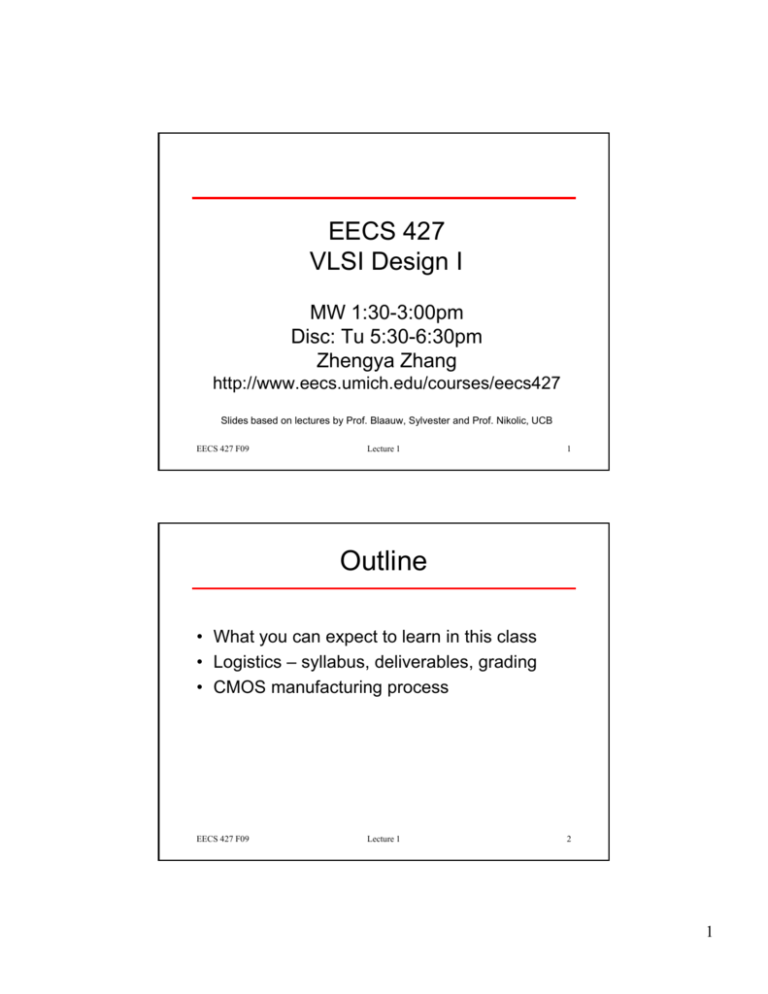
EECS 427 VLSI Design I MW 1:30-3:00pm Disc: Tu 5:30-6:30pm Zhengya Zhang http://www.eecs.umich.edu/courses/eecs427 Slides based on lectures by Prof. Blaauw, Sylvester and Prof. Nikolic, UCB EECS 427 F09 Lecture 1 1 Outline • What you can expect to learn in this class • Logistics – syllabus, deliverables, grading • CMOS manufacturing process EECS 427 F09 Lecture 1 2 1 The First Computer • The Babbage Difference Engine – 25,000 parts – cost: £17,470 EECS 427 F09 Lecture 1 3 ENIAC EECS 427 F09 Lecture 1 4 2 The First Transistor First transistor Bell Labs, 1948 EECS 427 F09 Lecture 1 5 The First Integrated Circuits Bipolar p logic g 1960’s ECL 3-input Gate Motorola 1966 EECS 427 F09 Lecture 1 6 3 Intel 4004 Intel, 1971. 2 300 transistors (12mm2) 2,300 740 KHz operation (10m PMOS technology) EECS 427 F09 Lecture 1 7 Intel Pentium 4 Intel, 2005. 125 000 000 transistors 125,000,000 (112mm2) 3.8 GHz operation (90nm CMOS technology) EECS 427 F09 Lecture 1 8 4 Intel Core2 Intel, 2006. 291 000 000 transistors 291,000,000 (143mm2) 3 GHz operation (65nm CMOS technology) EECS 427 F09 Lecture 1 9 Moore’s Law In 1965, 1965 Gordon Moore noted that the number of transistors on a chip doubled every 18 to 24 months. He made a prediction that semiconductor technology will double its effectiveness every 18 months EECS 427 F09 Lecture 1 10 5 Transistor Counts Transistor Counts in Intel's Microprocessors 1000 Trans sistors [in millions] Itanium II 100 10 486DX 1 Pentium II Itanium Pentium Pro Pentium III Pentium Pentium MMX 486DX4 80286 01 0.1 8086 0.01 Core2 Pentium 4 8008 0.001 1970 386DX 8088 Doubles every 2 years 8080 4004 EECS 427 F09 1975 1980 1985 1990 1995 2000 Lecture 1 2005 11 What you will learn in 427 • 312 – Transistors design and behavior • 270 – Logic g design g – combining g transistors • 370 – Architecture – high level organization • 427 – VLSI: realization of circuits in silicon: – – – – – The entire process of very large-scale integration Generation of custom layout Sub-system design such as adders, register files.. Synthesis + automated place/route design flow Advanced circuit design topics: pulsed latches, memory decoder and sense amplifiers, power, etc. – Project – Focus on Custom Design – Teamwork EECS 427 F09 Lecture 1 12 6 Non-Disclosure Agreement EECS 427 F09 Lecture 1 13 Teaching Staff • • • • Primary instructor: – Zhengya Zhang • 2416 EECS, zhengya at eecs.umich • Office hours: MW 3-4pm (tentative). (tentative) Both lecture material and project. GSI: – Wei-Hsiang Ma • 2713 CSE, wsma at umich • Office hours: MTh 4-6pm, Tu 6:30-7:30pm • Support of CAD (Computer-Aided Design) tools and project related issues as well as lecture material. Reader: – Bhavi Bhadviya • bhavi bh i att umich i h Staff support: – Joel Van Laven • Major CAD tool issues (pertaining to the project); consult after WeiHsiang EECS 427 F09 Lecture 1 14 7 Course Setup • Mon and Wed lectures in 185 EWRE • Tuesday uesday discussion d scuss o sec section o led ed by Wei-Hsiang e s a g Ma a (1003 EECS) – Purpose of discussion: review lecture topics, review CAD assignments and answer project related questions • Homework assignments – Only 1 ‘typical’ HW, others handle planning issues of project (groups, initial proposal, etc.) • CAD assignments – R Roughly hl weekly, kl severall 2+ 2+week k assignments i t – Each assignment represents a component of your final microprocessor design – First 2 are individual, rest are in groups • Quizzes: 2 - roughly every 6 weeks, non-cumulative. EECS 427 F09 Lecture 1 15 Project • Main component of class, 70+% of your grade • Design a 16-bit RISC (reduced instruction set computing) processor – Groups of 4 (you choose) • Good to have a mix of EE and CE • Baseline architecture (instruction set) given to you; you choose and implement a circuit-level enhancement technique – Time requirements: 30-40 hrs/week avg. 427 → 24/7 – Peer contribution forms; must pull your weight • Learn full-custom design (datapath) and automation tools (logic synthesis + custom router + place/route) • You can send this design off to be fabricated and then test it later as a directed study or possibly in EECS 579 (encouraged!) EECS 427 F09 Lecture 1 16 8 Logistics • Course Textbook: Digital Integrated Circuits: A Design Perspective, 2nd edition by Rabaey Rabaey, Chandrakasan Chandrakasan, and Nikolic • Lecture notes will be posted online shortly after class sessions and I will bring copies to class for note taking • Book will be supplemented with several handouts from other sources throughout the semester • Other Oth b books k on reserve att M Media di Union U i (W (Weste, t Chandrakasan) – Weste/Harris in particular is recommended if you want to pursue a career/graduate studies in digital circuits EECS 427 F09 Lecture 1 17 Grade Breakdown • Your project, in the form of CAD assignments and final report/presentation report/presentation, is the dominant part of your grade Homework CAD assignments Quizzes Final project/report, indiv. contrib. 10% 35% 24% ((12% each)) 31% CAD late policy: within 24 hours = 25% penalty, 24-48 hours = 50% penalty, see course info handout EECS 427 F09 Lecture 1 18 9 Project Schedule • • • • • • • • • • • • All CAD assignments due at 7 pm except CAD9 Tutorial (CAD): Wednesday, September 9, 7-9pm at CSE 1620 ) Wednesday, y, September p 16 CAD1 ((inverter/nand/mux): CAD2 (D flip-flop): Monday, September 21 CAD3 (register file): Wednesday, September 30 CAD4 (ALU): Wednesday, October 14 CAD5 (shifter): Wednesday, October 28 Tutorial (synthesis, place & route): Tuesday, November 3 CAD6 (datapath): Wednesday, November 4 CAD7 (program counter): Wednesday, Wednesday November 11 CAD8 (controller): Wednesday, November 18 CAD9 (completion): – Presentation & demo: Monday Dec 14 in class – Report due: Same day (Dec. 14) at 1:30pm EECS 427 F09 Lecture 1 19 Homework Schedule • • • • • • • All HW assignments due at 1:30 pm in class HW1 (problem set): Monday, September 21 HW2 (form a team): Monday Monday, September 28 HW3 (initial proposal): Wednesday, October 7 HW4 (detailed proposal): Monday, November 16 HW5 (final report): Monday, December 14 HW6 (presentation): Monday, December 14 EECS 427 F09 Lecture 1 20 10 Quiz and Holiday Schedule • Quiz 1: Wednesday, October 14 in class • Fall student break: October 19, 20 • Quiz 2: Monday, November 23 in class • Thanksgiving break: November 26, 27 • Last day of class: Monday, December 14 • No final exam EECS 427 F09 Lecture 1 21 Lecture Schedule Date Topic Reading/Coverage September 9 9/14 Course Introduction, Manufacturing Design Rules & Layout 9/16 9/21 CMOS Review Logical Effort 1.1-1.3 (review), 2.2, WH 3.2 2.3, Insert A, WH 1.5, WH 3.3 5.4, 6.2 handouts 9/23 9/28 9/30 October 5 10/7 Logical Effort Logic Styles Adders Adders Shifters handouts 6.2 11.1-11.3.1 11.3.2-11.3.3 11.5, WH 10.8 0/ Multipliers u p es 10/12 10/14 Quiz 1 10/19, 10/20 - Fall Study Break, No Classes EECS 427 F09 Notes, assignments due Tutorial1 (7-9pm) CAD1 due HW1 due CAD2 due HW2 due (teams) CAD3 due HW3 due (initial proposal) 11.4 Lecture 1 CAD4 due 22 11 Lecture Schedule 10/21 10/26 10/28 November 2 11/4 Power and Energy Dynamic Power Reduction Leakage Power Reduction Dynamic Logic Interconnects 11/9 11/11 11/16 Design Styles, Synthesis Timing, skew/jitter Timing cont., D-Q, pulsed latches 11/18 Memory Core and Peripherals 11/23 Quiz 2 11/25 Memory Reliability and Power 11/26, / 6, 11/27 / - Thanksgiving a sg g Break, ea , No o Classes C asses EECS 427 F09 5.5, 6.3, CBF 7 11.7 6.4.2, CBF 4 6.3 4.3.1, 4.3.2, 4.4.14.4.3, 9.3.3 8.1-8.4 10.1-10.3 10.3, 7.4 12.1-12.3 CAD5 due CAD6 due CAD7 due HW4 due (detailed proposal) CAD8 due 12.4, 12.5 Lecture 1 23 Lecture Schedule 11/30 December 2 Design-for-Test (DFT) Clock Distribution & Robustness 12/7 Advanced Interconnect Techniques Power Grid and Other Issues 12/9 12/14 EECS 427 F09 Insert H.3, CBF Ch. 25 10.3.3, 10.6, CBF Ch. 13 9.5 WH 12.3, CBF 24 Final Project Demos Final Project Presentations Lecture 1 Course evaluations in class CAD9: final due HW5 due (report) HW6 (presentation) 24 12 5 Minute break! EECS 427 F09 Lecture 1 25 CMOS Process EECS 427 F09 Lecture 1 26 13 A Modern CMOS Process gate-oxide TiSi2 AlCu SiO2 Tungsten poly p-well n+ SiO2 n-well p-epi p+ p+ Dual--Well TrenchDual Trench-Isolated CMOS Process EECS 427 F09 Lecture 1 27 Circuit Under Design VDD VDD M2 M4 Vout Vin M1 EECS 427 F09 Lecture 1 Vout2 M3 28 14 Its Layout View EECS 427 F09 Lecture 1 29 Photolithographic Process optical mask oxidation photoresist removal (ashing) photoresist coating stepper exposure Typical operations in a single photolithographic cycle (from [Fullman]). photoresist development acid etch process step EECS 427 F09 spin, rinse, dry Lecture 1 30 15 Patterning of SiO2 Chemical or plasma etch Si-substrate Hardened resist SiO 2 (a) Silicon base material Si-substrate Photoresist SiO 2 (d) After development and etching of resist, chemical or plasma etch of SiO 2 Si-substrate Hardened resist SiO 2 (b) After oxidation and deposition of negative photoresist Si-substrate UV-light Patterned optical mask (e) After te etc etching g Exposed resist SiO 2 Si-substrate Si-substrate (c) Stepper exposure EECS 427 F09 (f) Final result after removal of resist Lecture 1 31 CMOS Process at a Glance Define active areas Etch and fill trenches Implant well regions Deposit and pattern polysilicon layer Implant source and drain regions and substrate contacts Create contact and via windows Deposit and pattern metal layers EECS 427 F09 Lecture 1 32 16 CMOS Process Walkthrough p-epi (a) Base material: p+ substrate with p-epi layer p+ SiN 34 SiO 2 p-epi p+ (b) After deposition of gate-oxide and sacrificial nitride (acts as a buffer layer) (c) After plasma etch of insulating trenches using the inverse of the active area mask p+ EECS 427 F09 Lecture 1 33 CMOS Process Walkthrough SiO 2 (d) After trench filling, CMP planarization, planarization and removal of sacrificial nitride n (e) After n-well and Vthp adjust implants p EECS 427 F09 (e) After p-well and Vthn adjust implants Lecture 1 34 17 CMOS Process Walkthrough poly(silicon) (g) After polysilicon deposition and etch n+ p+ (h) After n+ source/drain and p+ source/drain implants. These steps also dope poly. SiO 2 (i) After deposition of SiO2 insulator and contact hole etch EECS 427 F09 Lecture 1 35 CMOS Process Walkthrough Al (j) After deposition and patterning of first Al layer. Al SiO 2 (e) After deposition of SiO2 Insulator, etching of vias, deposition and patterning of 2nd layer of Al EECS 427 F09 Lecture 1 36 18 Looking Ahead • http://jas.eng.buffalo.edu/education/fab/invFab/index.html • Read Sections 1.1, 1.2, 1.3.2-1.3.4, and 2.2 of Rabaey (mostly review) • Next lecture: we’ll cover design rules and layout styles • • • • • Logistics and due dates: Go to tutorial tonight CAD1 is due 9/16 HW1 is due 9/21 F Form your group!! EECS 427 F09 Lecture 1 37 19
